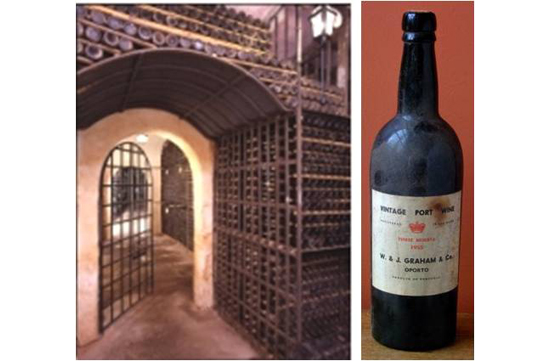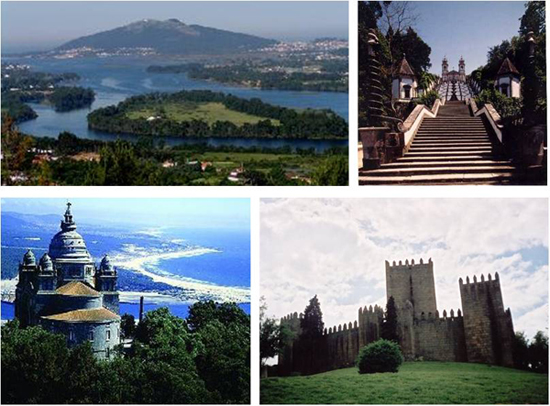Porto surroundings
The region and the Douro Valley
Douro is located in the northeast of Portugal, protected from the humid Atlantic winds by the Marão and Montemuro mountains. It is surrounded in the north by Trás-os-Montes, in the west by Minho and Porto and in the east by the Spanish regions of Castile and Leon.
In 2001 UNESCO inscribed the Alto Douro Wine Region in the World Heritage List. Probably one of the most picturesque and amazingly scenic regions in all of Europe, the Douro Valley is truly a magical place. It is possible to join one day excursions from Porto, to visit the best spots in the Douro including Port Wine Tasting and lovely views to remember.

Douro Valley Vineyards
The Port Wine Cellars
Port Wine, a symbol of Portugal in the world, holds the history of a country and its people and has become through the years a cultural landmark of the work, experiences, knowledge and art gathered through generations. Encloses in itself years and years of history and tradition, and it is attached to a region - The Douro Region - whose beautiful landscapes, source of attraction since the first moment for never to be forgotten, were influenced by it.
The Port Wine cellars are the right place to discover this Portuguese wine and all of its history. Open to the public, they give you the opportunity to taste this precious nectar, to meet its evolution through the years, the region where it is produced and the way it is obtained.

Port wine cellars
North of Portugal
In the north-western part of the country lies this land of dense vegetation and profound historic wealth. It was here that Portugal's first king, Dom Afonso Henriques, was born in the beginning of the 12th century, having then extended the kingdom to the south, in what was considered as one of the most heroic feats of the Christian Reconquest in the Iberian Peninsula. The inheritance of a distant past is seen everywhere.
It is possible to stay at one of the excellent manor-houses and mansions with coats of arms, and enjoy the aristocratic tradition of hospitality. Along with this unreproachable art one may en joy an abundant gastronomy, light, acidulous wines (vinhos verdes) and rich wines, and a variety of handicrafts that mingles the shine of` the filigree with the colour of the local embroideries.
The country's longest motorway (A1, from Lisbon to Porto) goes up to Braga (A3), in the heart of Costa Verde. If you follow the coastline on the road from Vila do Conde to Valença, you will not miss the beautiful beaches, seaside resorts and enchanting villages such as Caminha and Vila Nova de Cerveira. Inland and worthwhile visiting is the Peneda-Gerês National Park. Throughout the region the rivers, waterfalls, vineyards and fertile plots combine with the ancestral monuments in urban centres.

Views from the North of Portugal
Historical cities from north of Portugal
Braga
Founded by the Celts in 300 B.C. and a Roman administrative centre in 27 B.C., Bracara Augusta, as the Romans named it, combines the religious importance with today's commercial and industrial prosperity.
To visit: the Cathedral (12th-18th centuries), the Treasury and Sacred Art Museum; the Museum at the Biscainhos Palace; and the Dom Diogo de Sousa Museum.
Also deserving to be visited are the churches of Misericórdia (Renaissance), Pópulo (17th-18th centuries) and of Nossa Senhora Branca (18th century). On the outskirts, 5 km away from the centre, stands the Sanctuary of Bom Jesus do Monte, with its monumental Baroque staircase; the Sanctuary of Nossa Senhora do Sameiro; the ancient Monastery of Tibães, dating back to the Suevian period and rebuilt in the 11th century, and the Church of São Frutuoso de Montélios (7th century Visigothic temple). Bragança - Majestic city, with medieval castle and walls, amongst which is the Domus Municipalis, a unique example of civic Romanesque architecture. Special mention must be made to the Cathedral (16th century), Santa Maria Church, Casa da Misericórdia Chapel, Santa Clara Convent and Church (16th century), São Bento Convent and Church (17th-18th centuries), and the Abade de Baçal Museum. At the Railways Museum, 19th century locomotives and carriages.
Guimarães
Portugal's birthplace, with medieval castle and walls, houses a magnificently well preserved historic centre. In the cloisters of the Church of Nossa Senhora da Oliveira is the Alberto Sampaio Museum; in the cloister of São Domingos Convent is the Martins Sarmento Museum; and in the ancient Dominican Convent is the Sacred Art Museum. Also deserving special mention are the medieval palace of the Dukes of Bragança (15th century), the Church of São Miguel (Romanesque), the Church of Santos Passos (Baroque), and the Monastery of Santa Marinha da Costa (a pousada). Nearby lies the early settlement of Briteiros.
Viana do Castelo
Spread along the north bank of the Lima estuary (where one can take trips on typical boats), this town is famous for its handicrafts and colourful regional costumes. Deserving special mention are the mother-church, the ancient Paços do Concelho (both Gothic), Casa da Misericórdia (Renaissance with a sacred art treasure), the medieval Casa dos Arcos, the Convent of Santa Ana (16th century), and the Regional Museum. Up above and dominating the city is the Sanctuary of Santa Luzia, with a fantastic view of Viana, the river and the ocean.
Vila Real
Founded in 1272, its monuments reflect the city's long history. A town with great diversity of religious architecture: Cathedral and São Brás Chapel (Gothic); churches of São Pedro and Misericórdia (16th century), São Dinis (16-18th centuries) and the Baroque Capela Nova and Clérigos Church. Also worthwhile visiting is the famous Mateus Palace, a Baroque masterpiece, where cultural events are currently held.